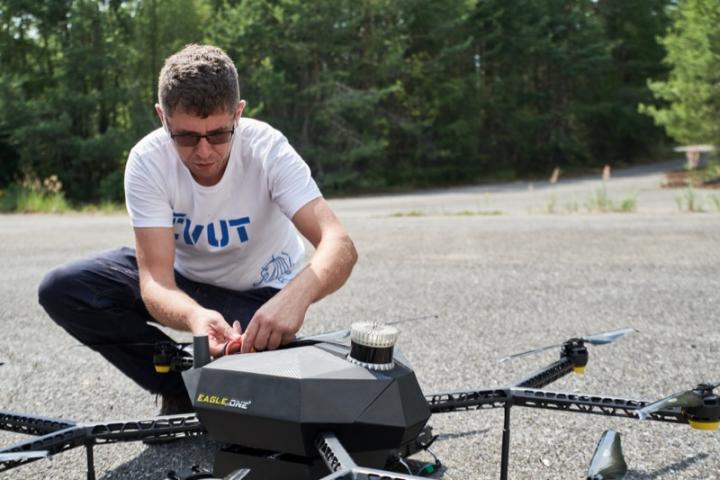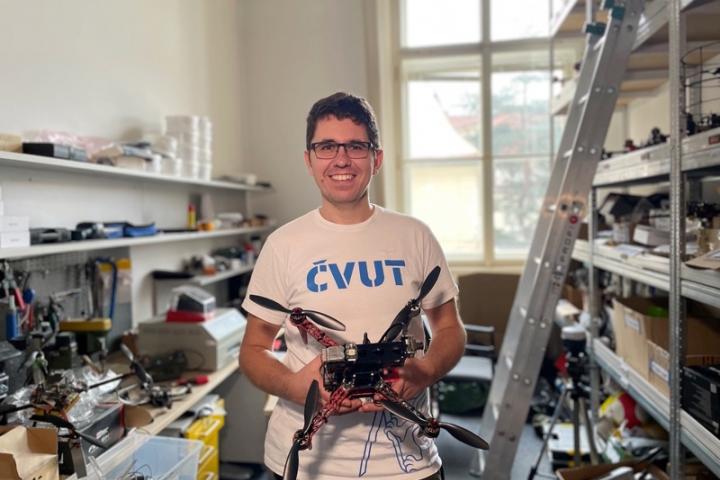
A total of 50 applicants under the age of 33, nominated by a university or the Academy of Sciences on the basis of the quality of their doctoral research work, took part in the competition. The results were decided by six committees composed of 37 Czech and French professors and scientists.
"In the end, eleven very good candidates competed in my filed. The fact that I took the second place is a great satisfaction for me, a confirmation that my work has and will have meaning," adds Tomáš Báča himself. The French Embassy itself is convinced of this, too, offering the first and second prize winners a scholarship to spend a month's research stay in a French laboratory of their choice.
The award-winning research work by Tomáš Báča: Cooperative Sensing by a Group of Unmanned Aerial Vehicles, consisted of three research pillars. The main one was the research and development of a drone control system for the purpose of experimental validation of fundamental research in the field of multi-robotic systems. The work included the design of a modular system for control, state estimation, planning, trajectory tracking and flight management. This system is freely available as "free software" and "open source" to the robotics community, used extensively. The system is also used for teaching. It has been hosted twice at the IEEE MRS Summer School. This will be the third time that the system has been used in our country, and even with this year's instruction, over four hundred students have used the system.
Dalším pilířem oceněné práce byl výzkum v oblasti distribuovaného měření pomocí autonomních dronů. „V rámci tématu jsem se zabýval automatickým sběrem objektů ze země za pomoci skupiny dronů, automatickým stavěním zdi z cihel skupinou dronů a automatickým přistáním dronu na jedoucím automobilu. Všechny tyto úkoly byly prezentovány na robotických soutěžích, kde jsme získali mnoho ocenění mezi prestižními týmy z celého světa,“ vysvětluje Tomáš Báča.
Another pillar of the award-winning work was research into distributed measurement using autonomous drones. "Within the topic, I looked at the automatic collection of objects from the ground using a group of drones, the automatic building of a brick wall by a group of drones, and the automatic landing of a drone on a moving car. All these tasks were presented at robotics competitions where we won many awards among prestigious teams from all over the world," explains Tomáš Báča.
The third and last pillar of his work was the research of methods for localization and mapping of ionizing radiation sources. Achievements by Tomáš Báča are illustrated, for example, by the fact that he is the author of the device for radiation mapping on the VZLUSAT-1 satellite, which works on the principle of the Timepix pixel detector.
He has been dealing with the topic of drones since his high school years, i.e. since the very beginning of the field. He is one of the founding members of the Multi-Robot Systems group at the CTU Faculty of Engineering, which has been working on drones since 2014. The group now consists of 35 researchers, PhD students and students. "The future of drones seems to be very interesting. Their abilities and possibilities of their use are moving incredibly forward every year, and I see huge potential in their deployment in rescue missions both outdoors and inside buildings and underground," concludes Tomáš Báča.
His dissertation „Cooperative Sensing by a Group of Unmanned Aerial Vehicles“ is available for reading as a whole.

foto: P. Neugebauer